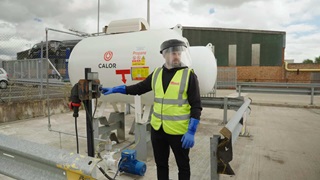Gas Safety Week – Expert advice on changing and refilling LPG cylinders for FLTs

How do I know when to change or refill an LPG cylinder?
The refillable LPG cylinders on FLTs have a contents gauge on them – this can be checked easily so you know when you are about to run out of gas.
The non-refillable cylinder does not come with a contents gauge; the easiest way to know when the cylinder needs replacing is when the forklift truck starts to lose power.
Once a cylinder needs to be replaced or refilled, what PPE should be worn?
When changing or refilling a cylinder, it’s important to wear correct PPE. This is because LPG in its liquid form can give you a cold burn if it makes contact with the skin.
The correct PPE to wear when refilling a forklift truck cylinder is a face shield or visor, a long-sleeved top that is preferably made from cotton, and neoprene or nitrile gloves – preferably the gauntlets. You should also wear safety boots and a hi-vis vest.
How to refill an FLT gas cylinder?
When refuelling a refillable LPG cylinder, you should park up to three metres away from the bulk storage tanks; then apply the handbrake and turn the engine off.
Once you’ve checked the content gauge to see if it needs to be refilled, attach the filling hose and gun from the bulk tank installation to the filler valve on the cylinder. You should check the connection on both the hose and the filler valve to make sure they are in good condition.
Now the hose and gun are connected, you can open the bleed valve that is on the refillable cylinder; there should be a small release of gas and once that has happened, you can then start conveying liquid by using the dead man switch on the installation.
When you start seeing liquid appear, which will be shown with a white jet coming out the bleed valve, stop filling immediately and close the bleed valve. Then depress the gun to release it and make sure the connection is depressurised. Once you’ve stowed the hose and gun away, return to the cylinder to put the filler valve cap back on.
How to replace a non-refillable gas cylinder?
With a non-refillable cylinder, park up your forklift truck, apply the handbrake and close the service valve on the cylinder before turning the engine off.
You should then let the forklift truck engine die so you can close the service valve and disconnect the cylinder in order to remove it from the back of the forklift truck.
To check that the cylinder has been fitted correctly, make sure that it is secure; on the bottom of the cylinder, there is a white arrow which will tell you if the placement is correct. The white arrow should be pointing in the down position.
When fitting the new cylinder on the back of the forklift truck, we advise to have someone assist you. Once the cylinder is safely secured, you can start the engine as normal.
How should LPG be stored?
There are multiple options for LPG storage depending on a business’ requirements, including a bulk tank or gas cylinders. Regardless of which method is used, training is advised to ensure the team is confident in how to manage it safely.
Cylinder storage
LPG cylinders should be stored in accordance with Liquid Gas (Previously UKLPG) Code of Practice No. 7 ‘Storage of Full and Empty LPG Cylinders and Cartridges’. Separation distances vary depending on the quantities of LPG being stored, however, the main requirements are: the use of a purpose built compound cage; segregation of full and empty cylinders; and separation from flammable liquids, combustible, oxidising, corrosive, toxic materials and compressed gas cylinders.
Bulk tank storage
The Siting of bulk tanks used to refuel cylinders is also important. Depending on the size of the tank they should be installed a minimum of three metres away from other buildings, property boundaries or ignition sources. They should also have adequate vehicle protection in the form of barriers or bollards to ensure no vehicles can drive into the installation. In addition, no flammable objects including wooden pallets or refuse should also be stored here.
How should refillable LPG cylinders be handled?
It is important when fitting a cylinder onto a forklift truck that it is positioned correctly. A Calor Liquid Offtake Cylinder (LOT) cylinder is designed to give liquid propane offtake only when operating in the horizontal position. The body of the LOT cylinder is painted red and the shroud black. When horizontally mounted LOT cylinders are used, the arrow on the base must be pointing vertically downwards with the locating peg fitted to the hole in the cylinder shroud. The cylinder must then be securely clamped.
Leaks
What to do if you suspect a leak in your gas cylinder?
If you detect a leak in the cylinder, you should contact Calor on our emergency line right away. If it is safe to do so, the cylinder should be moved to an outside location away from any open drains, ignition sources or any combustible materials.
What to do if you suspect a leak in your gas tank?
If there is a leak on the gas tank or any equipment connected to it, then contact our emergency line straight away and they’ll dispatch an engineer to you as soon as possible. Safety is Calor’s number one priority, and we want to ensure that our customers, staff and other members of the public can all go home safe at the end of the day.
FLT Training
Please note, this article is for raising safety awareness and is not a replacement of taking an FLT safety training. If you’re interested in booking Calor FLT safety training for your employees, please email us on: CETraining@calor.co.uk